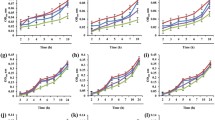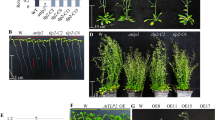Abstract
Translationally controlled tumor protein (TCTP), also termed P23 in human, belongs to a family of calcium- and tubulin-binding proteins, and it is generally regarded as a growth-regulating protein. Recently, Arabidopsis TCTP (AtTCTP) has been reported to function as an important growth regulator in plants. On the other hand, plant TCTP has been suggested to be involved in abiotic stress signaling such as aluminum, salt, and water deficit by a number of microarray or proteomic analyses. In this study, the biological functions of AtTCTP were investigated by using transgenic Arabidopsis plants overexpressing AtTCTP. Interestingly, AtTCTP overexpression enhanced drought tolerance in plants. The expression analysis showed that AtTCTP was expressed in guard cells as well as in actively growing tissues. Physiological studies of the overexpression lines showed increased ABA- and calcium-induced stomatal closure ratios and faster stomatal closing responses to ABA. Furthermore, in vitro protein-protein interaction analysis confirmed the interaction between AtTCTP and microtubules, and microtubule cosedimentation assays revealed that the microtubule binding of AtTCTP increased after calcium treatment. These results demonstrate that the overexpression of AtTCTP confers drought tolerance to plants by rapid ABA-mediated stomatal closure via the interaction with microtubules in which calcium binding enhances the interaction. Collectively, the present results suggest that the plant TCTP has molecular properties similar to animal TCTPs, such as tubulin- and calcium-binding, and that it functions in ABA-mediated stomatal movement, in addition to regulating the growth of plants.
Similar content being viewed by others
References
Allen, G.J., Kwak, J.M., Chu, S.P., Llopis, J., Tsien, R.Y., Harper, J.F., and Schroeder, J.I. (1999). Cameleon calcium indicator reports cytoplasmic calcium dynamics in Arabidopsis guard cells. Plant J. 19, 735–747.
Ascencio-Ibanez, J.T., Sozzani, R., Lee, T.J., Chu, T.M., Wolfinger, R.D., Cella, R., and Hanley-Bowdoin, L. (2008). Global analysis of Arabidopsis gene expression uncovers a complex array of changes impacting pathogen response and cell cycle during geminivirus infection. Plant Physiol. 148, 436–454.
Bazile, F., Pascal, A., Arnal, I., Le Clainche, C., Chesnel, F., and Kubiak, J.Z. (2009). Complex relationship between TCTP, micro-tubules and actin microfilaments regulates cell shape in normal and cancer cells. Carcinogenesis 30, 555–565.
Berkowitz, O., Jost, R., Pollmann, S., and Masle, J. (2008). Characterization of TCTP, the translationally controlled tumor protein, from Arabidopsis thaliana. Plant Cell 20, 3430–3447.
Blatt, M.R. (2000). Cellular signaling and volume control in stomatal movements in plants. Annu. Rev. Cell Dev. Biol. 16, 221–241.
Bommer, U.A., and Thiele, B.J. (2004). The translationally controlled tumour protein (TCTP). Int. J. Biochem. Cell Biol. 36, 379–385.
Bonnet, C., Perret, E., Dumont, X., Picard, A., Caput, D., and Lenaers, G. (2000). Identification and transcription control of fission yeast genes repressed by an ammonium starvation growth arrest. Yeast 16, 23–33.
Brioudes, F., Thierry, A.M., Chambrier, P., Mollereau, B., and Bendahmane, M. (2010). Translationally controlled tumor protein is a conserved mitotic growth integrator in animals and plants. Proc. Natl. Acad. Sci. USA 107, 16384–16389.
Cans, C., Passer, B.J., Shalak, V., Nancy-Portebois, V., Crible, V., Amzallag, N., Allanic, D., Tufino, R., Argentini, M., Moras, D., et al. (2003). Translationally controlled tumor protein acts as a guanine nucleotide dissociation inhibitor on the translation elongation factor eEF1A. Proc. Natl. Acad. Sci. USA 100, 13892–13897.
Chen, S.H., Wu, P.S., Chou, C.H., Yan, Y.T., Liu, H., Weng, S.Y., and Yang-Yen, H.F. (2007). A knockout mouse approach reveals that TCTP functions as an essential factor for cell proliferation and survival in a tissue-or cell type-specific manner. Mol. Biol. Cell 18, 2525–2532.
Chitpatima, S.T., Makrides, S., Bandyopadhyay, R., and Brawerman, G. (1988). Nucleotide sequence of a major messenger RNA for a 21 kilodalton polypeptide that is under translational control in mouse tumor cells. Nucleic Acids Res. 16, 2350.
Clough, S.J., and Bent, A.F. (1998). Floral dip: a simplified method for Agrobacterium-mediated transformation of Arabidopsis thaliana. Plant J. 16, 735–743.
Desai, A., and Mitchison, T.J. (1997). Microtubule polymerization dynamics. Annu. Rev. Cell Dev. Biol. 13, 83–117.
Ermolayev, V., Weschke, W., and Manteuffel, R. (2003). Comparison of Al-induced gene expression in sensitive and tolerant soybean cultivars. J. Exp. Bot. 54, 2745–2756.
Fabro, G., Di Rienzo, J.A., Voigt, C.A., Savchenko, T., Dehesh, K., Somerville, S., and Alvarez, M.E. (2008). Genome-wide expression profiling Arabidopsis at the stage of Golovinomyces cichoracearum haustorium formation. Plant Physiol. 146, 1421–1439.
Feng, Y., Liu, D., Yao, H., and Wang, J. (2007). Solution structure and mapping of a very weak calcium-binding site of human translationally controlled tumor protein by NMR. Arch. Biochem. Biophys. 467, 48–57.
Gachet, Y., Tournier, S., Lee, M., Lazaris-Karatzas, A., Poulton, T., and Bommer, U.A. (1999). The growth-related, translationally controlled protein P23 has properties of a tubulin binding protein and associates transiently with microtubules during the cell cycle. J. Cell Sci. 112, 1257–1271.
Galatis, B., and Apostolakos, P. (2004). The role of the cytoskeletn in the morphogenesis and function of stomatal complexes. New Phytol. 161, 613–639.
Gnanasekar, M., Dakshinamoorthy, G., and Ramaswamy, K. (2009). Translationally controlled tumor protein is a novel heat shock protein with chaperone-like activity. Biochem. Biophys. Res. Commun. 386, 333–337.
Goh, C.-H., Schreiber, U., and Hedrich, R. (1999). New approach of monitoring changes in chlorophyll a fluorescence of single guard cells and protoplasts in response to physiological stimuli. Plant Cell Environ. 22, 1057–1070.
Gross, B., Gaestel, M., Bohm, H., and Bielka, H. (1989). cDNA sequence coding for a translationally controlled human tumor protein. Nucleic Acids Res. 17, 8367.
Heald, R., and Nogales, E. (2002). Microtubule dynamics. J. Cell Sci. 115, 3–4.
Hetherington, A.M., and Woodward, F.I. (2003). The role of stomata in sensing and driving environmental change. Nature 424, 901–908.
Hinojosa-Moya, J., Xoconostle-Cazares, B., Piedra-Ibarra, E., Mendez-Tenorio, A., Lucas, W.J., and Ruiz-Medrano, R. (2008). Phylogenetic and structural analysis of translationally controlled tumor proteins. J. Mol. Evol. 66, 472–483.
Howard, J., and Hyman, A.A. (2003). Dynamics and mechanics of the microtubule plus end. Nature 422, 753–758.
Hsu, Y.C., Chern, J.J., Cai, Y., Liu, M., and Choi, K.W. (2007). Drosophila TCTP is essential for growth and proliferation through regulation of dRheb GTPase. Nature 445, 785–788.
Jefferson, R.A., Kavanagh, T.A., and Bevan, M.W. (1987). GUS fusions: beta-glucuronidase as a sensitive and versatile gene fusion marker in higher plants. EMBO J. 6, 3901–3907.
Jiang, C.J., Nakajima, N., and Kondo, N. (1996). Disruption of microtubules by abscisic acid in guard cells of Vicia faba L. Plant Cell Physiol. 37, 697–701.
Johansson, F., Sommarin, M., and Larsson, C. (1993). Fusicoccin activates the plasma membrane H+-ATPase by a mechanism involving the C-terminal Inhibitory domain. Plant Cell 5, 321–327.
Jones, A.M., Thomas, V., Bennett, M.H., Mansfield, J., and Grant, M. (2006). Modifications to the Arabidopsis defense proteome occur prior to significant transcriptional change in response to inoculation with Pseudomonas syringae. Plant Physiol. 142, 1603–1620.
Kang, J.Y., Choi, H.I., Im, M.Y., and Kim, S.Y. (2002). Arabidopsis basic leucine zipper proteins that mediate stress-responsive abscisic acid signaling. Plant Cell 14, 343–357.
Kim, M., Jung, Y., Lee, K., and Kim, C. (2000). Identification of the calcium binding sites in translationally controlled tumor protein. Arch. Pharm. Res. 23, 633–636.
Lahav, M., Abu-Abied, M., Belausov, E., Schwartz, A., and Sadot, E. (2004). Microtubules of guard cells are light sensitive. Plant Cell Physiol. 45, 573–582.
Li, F., Zhang, D., and Fujise, K. (2001). Characterization of fortilin, a novel antiapoptotic protein. J. Biol. Chem. 276, 47542–47549.
MacDonald, S.M., Rafnar, T., Langdon, J., and Lichtenstein, L.M. (1995). Molecular identification of an IgE-dependent histamine-releasing factor. Science 269, 688–690.
Marcus, A.I., Moore, R.C., and Cyr, R.J. (2001). The role of microtubules in guard cell function. Plant Physiol. 125, 387–395.
McAinsh, M.R., Webb, A., Taylor, J.E., and Hetherington, A.M. (1995). Stimulus-induced oscillations in guard cell cytosolic free calcium. Plant Cell 7, 1207–1219.
O’Brien, E.T., Salmon, E.D., and Erickson, H.P. (1997). How calcium causes microtubule depolymerization. Cell Motil. Cytoskeleton 36, 125–135.
Pierce, D.R., Hayar, A., Williams, D.K., and Light, K.E. (2010). Developmental alterations in olivary climbing fiber distribution following postnatal ethanol exposure in the rat. Neuroscience 169, 1438–1448.
Sanchez, J.C., Schaller, D., Ravier, F., Golaz, O., Jaccoud, S., Belet, M., Wilkins, M.R., James, R., Deshusses, J., and Hochstrasser, D. (1997). Translationally controlled tumor protein: a protein identified in several nontumoral cells including erythrocytes. Electrophoresis 18, 150–155.
Schmidt, I., Fahling, M., Nafz, B., Skalweit, A., and Thiele, B.J. (2007). Induction of translationally controlled tumor protein (TCTP) by transcriptional and post-transcriptional mechanisms. FEBS J. 274, 5416–5424.
Shelanski, M. L., Gaskin, F., and Cantor, C.R. (1973). Microtubule assembly in the absence of added nucleotides. Proc. Natl. Acad. Sci. USA 70, 765–768.
Sturzenbaum, S.R., Kille, P., and Morgan, A.J. (1998). Identification of heavy metal induced changes in the expression patterns of the translationally controlled tumour protein (TCTP) in the earthworm Lumbricus rubellus1. Biochim. Biophys. Acta 1398, 294–304.
Susini, L., Besse, S., Duflaut, D., Lespagnol, A., Beekman, C., Fiucci, G., Atkinson, A.R., Busso, D., Poussin, P., Marine, J.C., et al. (2008). TCTP protects from apoptotic cell death by antagonizing bax function. Cell Death Differ. 15, 1211–1220.
Thaw, P., Baxter, N.J., Hounslow, A.M., Price, C., Waltho, J.P., and Craven, C.J. (2001). Structure of TCTP reveals unexpected relationship with guanine nucleotide-free chaperones. Nat. Struct. Biol. 8, 701–704.
Thiele, H., Berger, M., Skalweit, A., and Thiele, B.J. (2000). Expression of the gene and processed pseudogenes encoding the human and rabbit translationally controlled tumour protein (TCTP). Eur. J. Biochem. 267, 5473–5481.
Vincent, D., Ergul, A., Bohlman, M.C., Tattersall, E.A., Tillett, R.L., Wheatley, M.D., Woolsey, R., Quilici, D.R., Joets, J., Schlauch, K., et al. (2007). Proteomic analysis reveals differences between Vitis vinifera L. cv. Chardonnay and cv. Cabernet Sauvignon and their responses to water deficit and salinity. J. Exp. Bot. 58, 1873–1892.
Vonakis, B.M., Macglashan, D.W., Jr., Vilarino, N., Langdon, J.M., Scott, R.S., and MacDonald, S.M. (2008). Distinct characteristics of signal transduction events by histamine-releasing factor/translationally controlled tumor protein (HRF/TCTP)-induced priming and activation of human basophils. Blood 111, 1789–1796.
Yang, Y., Yang, F., Xiong, Z., Yan, Y., Wang, X., Nishino, M., Mirkovic, D., Nguyen, J., Wang, H., and Yang, X.F. (2005). An Nterminal region of translationally controlled tumor protein is required for its antiapoptotic activity. Oncogene 24, 4778–4788.
Yu, R., Huang, R.F., Wang, X.C., and Yuan, M. (2001). Microtubule dynamics are involved in stomatal movement of Vicia faba L. Protoplasma 216, 113–118.
Author information
Authors and Affiliations
Corresponding author
About this article
Cite this article
Kim, YM., Han, YJ., Hwang, OJ. et al. Overexpression of Arabidopsis translationally controlled tumor protein gene AtTCTP enhances drought tolerance with rapid ABA-induced stomatal closure. Mol Cells 33, 617–626 (2012). https://doi.org/10.1007/s10059-012-0080-8
Received:
Revised:
Accepted:
Published:
Issue Date:
DOI: https://doi.org/10.1007/s10059-012-0080-8




